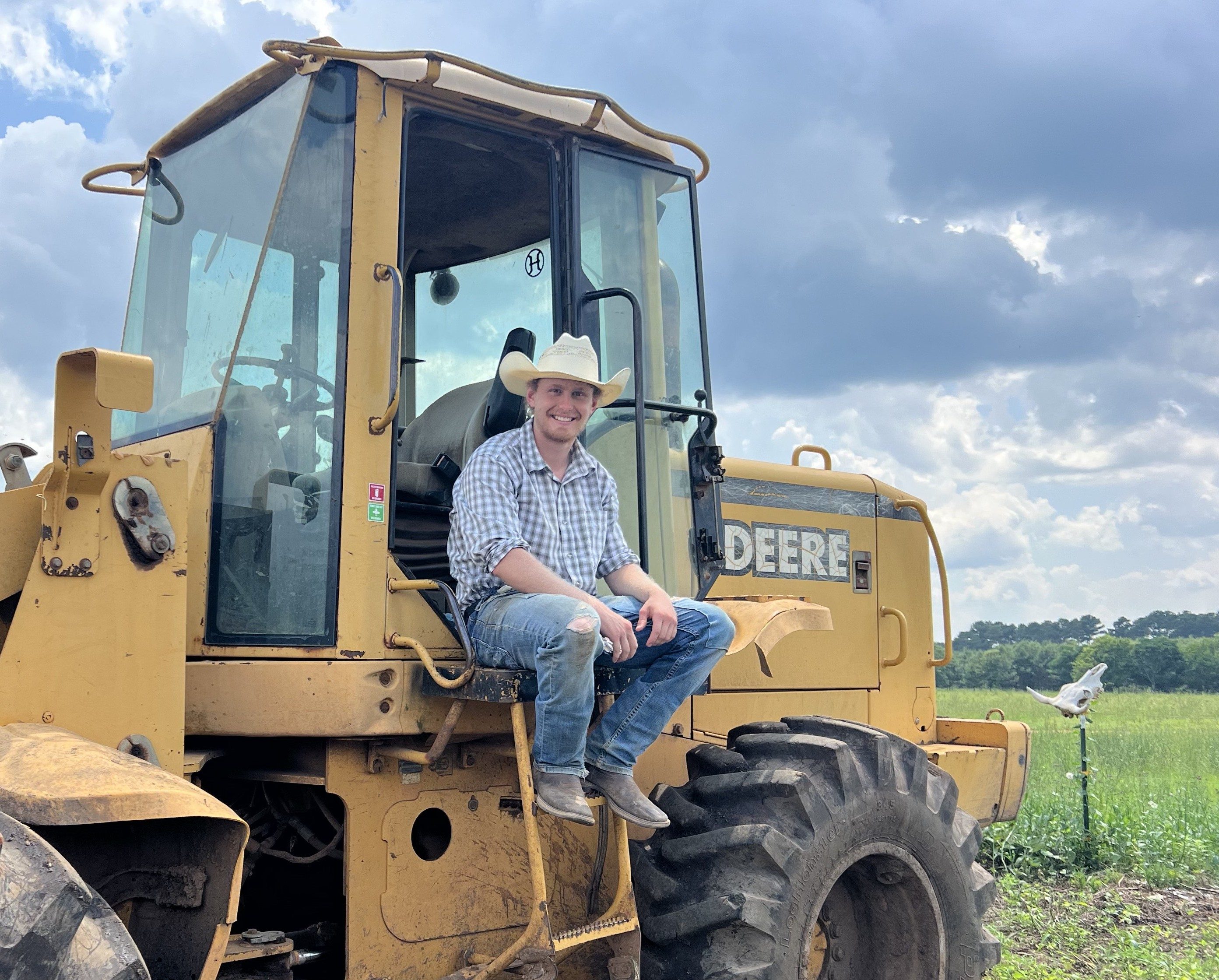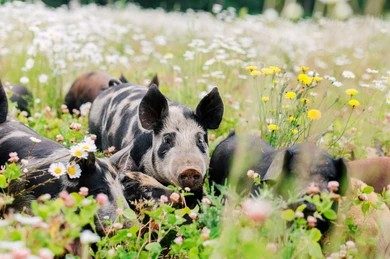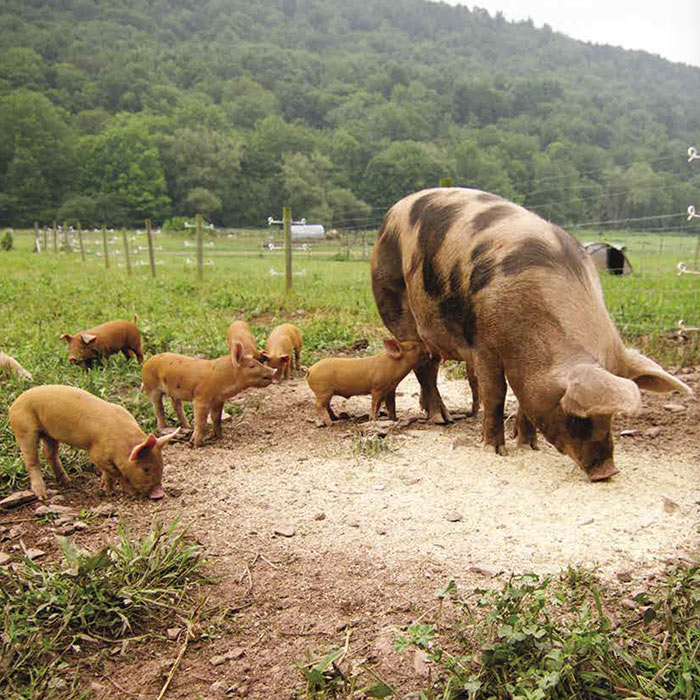TheFarmersDigest
The Farmers Digest
Jun 9, 2025

Editor
Chris Pigge

Editor
Miles Falk
Pastured Pigs: Crazy or Genius? (Part 1)
The first article in a comprehensive series exploring the complexities of pasture-based pig production

Raising pigs on pasture sounds simple enough—turn them out to graze and let nature take its course. The reality, however, tells a different story. Pasture-based pork production offers opportunities for niche meat producers to meet the desires of consumers concerned about the treatment of animals they eat, but it's not as simple as just turning pigs out to pasture.
Unlike the romanticized vision many newcomers hold, pasture pig operations represent one of agriculture's most challenging endeavors. Success requires intensive management, deep understanding of grass growth patterns, and constant vigilance against land damage. Get it wrong, and you can destroy productive pasture in remarkably short order.
The Fundamental Challenge: Pigs Aren't Ruminants
Before diving into management strategies, producers must understand a basic biological reality that shapes everything about pasture pig production. Pigs and humans are monogastrics, meaning we have one major stomach compartment and rely primarily on enzymes for digestion. This is in contrast to ruminants, which have three pre-stomach chambers devoted to fermentation of feedstuffs and an enzymatic stomach as well.
This digestive difference means pigs are unable to digest fiber well. They cannot survive on plants alone! Unlike cattle that can thrive on grass alone, pigs require substantial supplemental feeding regardless of pasture quality. The pasture component serves more for exercise, mental stimulation, and minor nutritional contribution rather than as a primary feed source.
Even large pastures can deteriorate quickly if not managed correctly. This deterioration stems from pigs' natural rooting behavior, which can destroy established grass stands with shocking efficiency.
The Rooting Reality: Understanding What Actually Happens and What It Means
Pig rooting behavior represents the single greatest challenge for pasture-based systems. While this behavior is completely natural and essential for pig welfare, it poses significant management challenges. To understand the challenge, producers need to visualize what actually happens when pigs root and how this impacts farm management decisions.
When pigs root, they're not simply scratching at the surface. They use their powerful snouts to dig 6-12 inches deep, searching for roots, grubs, worms, and other underground food sources. This behavior is instinctive—pigs are designed to be soil aerators and seed distributors in natural systems. Their snouts can exert tremendous pressure, easily breaking through tough sod and compacted soil.
Picture a well-established pasture with thick grass coverage. Within days of pigs arriving, small disturbed patches appear where they've rooted for food. Within a week, these patches expand and multiply. If left in the same area for several weeks, the rooting activity intensifies. What was once a uniform grass stand becomes a patchwork of bare soil, churned earth, and stressed grass plants.
The timeline of damage is predictable but varies with pig density and pasture conditions. In the first few days, rooting appears manageable—scattered holes and disturbed areas that seem like they might recover. By week two, the rooting has expanded significantly, with bare patches connecting to form larger disturbed areas. After a month without rotation, formerly productive pasture can resemble a plowed field, with little remaining grass and severely compacted soil in high-traffic areas.
The Management Implications: Opportunities and Challenges
This rooting behavior creates both opportunities and serious challenges that farmers must understand to succeed. The key lies in timing and intensity—the same behavior that can destroy a pasture can also serve valuable agricultural purposes when properly managed.
Short-term, controlled rooting offers several benefits. When pigs spend just one to three days in an area, their light rooting activity aerates compacted soil, incorporates surface organic matter, and can actually improve soil structure. This level of disturbance often stimulates dormant seeds already in the soil seed bank, potentially increasing plant diversity. The moderate soil disturbance can also help control certain weeds by disrupting their root systems without completely destroying the grass stand.
Intensive, planned rooting can serve as a biological tillage tool. Some producers strategically use pigs to prepare areas for reseeding, particularly when trying to establish new pasture species or food plots. The pigs effectively till the ground, eliminate existing vegetation, and deposit manure—creating an ideal seedbed. This approach works especially well for transitioning areas from poor pasture to improved species or for establishing annual forages.
Uncontrolled, extended rooting creates serious problems. Beyond destroying existing pasture, it can lead to soil compaction in wet conditions, create erosion potential on slopes, and establish weed problems in the disturbed areas. Once a thick grass stand is destroyed, it can take multiple seasons to reestablish, during which time the area may be largely unproductive and vulnerable to erosion.
The economic implications are significant. A farmer might lose $200-400 per acre in pasture productivity when good grass stands are destroyed, plus the cost and time needed for reestablishment. Conversely, strategic use of pig tillage can save $50-100 per acre in mechanical tillage costs when preparing areas for reseeding.
Traditional pig breeds compound this challenge. Most pigs have long, straight snouts that assist in rooting but can more easily destroy pasture settings. Shorter, upturned snouts help limit the amount of rooting, therefore minimizing excessive damage to pasture plants and aiding in pasture management. However, even pigs selected for reduced rooting ability can still cause significant pasture damage without proper management.
The trade-off becomes apparent quickly. Allow pigs to express natural behaviors, and accept that some level of pasture disturbance is inevitable. Restrict rooting behavior too aggressively, and you compromise animal welfare—one of the primary reasons many producers pursue pasture systems in the first place. Success requires learning to work with this behavior rather than fighting it, using strategic timing and rotation to harness the benefits while minimizing the damage.
Market Reality: Premium Pricing With Premium Costs
The economics of pasture pork present both opportunities and challenges that producers must understand before committing to this production method. Consumer interest in pastured pork has grown significantly, driven by concerns about animal welfare and perceived quality differences.
The financial contrast between pastured and conventional pork is dramatic. Based on current market data, direct-to-consumer pastured pork typically sells for $6.00 to $11.30 per pound depending on processing and cuts. Some operations report final retail equivalent prices reaching $11.30 per pound when accounting for processing losses and direct marketing. Meanwhile, conventional retail pork averages significantly less, with commodity prices reflecting the efficiency of large-scale production systems.
This price differential exists because conventional pork production benefits from economies of scale and efficiency. Consumer are used to paying very low prices for pork due to the efficiency of conventional production systems. Because of the litter size and maturity time, there is a much higher quantity of commodity pork available on the market.
However, pastured pork producers face substantially higher production costs per pound. The process of pasturing pork makes a smaller number of finished hogs in a year's time, and the man-hours per animal are greatly increased. Additionally, pastured operations typically cannot access large-scale processing facilities, requiring smaller, often more expensive processing options that further impact final costs.
Startup Costs: A Major Advantage
While ongoing production costs present challenges, the startup infrastructure costs for pasture pig operations represent a significant advantage over conventional systems. The capital required to establish a pasture pig operation is a fraction of what's needed to build modern confinement facilities.
Industrial hog barns require massive upfront investments—concrete floors, environmental control systems, manure handling equipment, ventilation systems, and automated feeding infrastructure. These facilities often cost hundreds of thousands or even millions of dollars before housing a single pig.
In contrast, pasture pig operations can begin with basic fencing, simple shelters, portable water systems, and feeders. Many successful operations start with used equipment and expand gradually as the business grows. This lower barrier to entry makes pasture pig production accessible to beginning farmers and those with limited capital, even though the ongoing operational costs per pound may be higher.
The Direct Marketing Imperative
Perhaps the most critical factor for pastured pork viability is understanding that this production system only works economically with direct-to-consumer sales or sales to high-end specialty markets. Attempting to sell pastured pork through conventional commodity channels is a recipe for financial disaster.
The price premiums that make pastured pork viable—$6.00 to $11.30 per pound—simply don't exist in commodity markets. Conventional pork processors and most retail chains purchase based on commodity pricing, which cannot support the higher production costs inherent in pasture systems. Even "natural" or "antibiotic-free" premium programs typically offer only modest premiums that fall far short of covering pastured pork's cost structure.
Direct marketing allows producers to capture the full value of their premium product by selling directly to consumers who appreciate and will pay for the quality differences. This might include farmers markets, on-farm sales, community-supported agriculture (CSA) programs, or direct online sales. High-end restaurants and specialty grocery stores represent another viable market channel for operations that can maintain consistent supply and quality.
This marketing reality means pastured pork producers must develop retail skills alongside their farming expertise. Success requires customer education, relationship building, proper packaging and labeling, and often significant time investment in marketing activities. Producers who struggle with direct marketing or prefer to focus solely on production may find pastured pork systems financially challenging regardless of their farming skills.
The flavor difference is real and noticeable to discerning consumers. Professional chefs have embraced pastured pork for its superior fat quality and richer flavor profile. Chef Cody Stone of Decca Restaurant in Louisville, Kentucky once conducted a blind test with Marksbury pastured pork vs a few popular brands of "natural" pork from out west. The result according to Cody: "It wasn't even close."
The Learning Curve Reality
Perhaps no aspect of pasture pig production is more underestimated than the learning curve involved. Science-based management practices for pasture pig operations are difficult to find. Rearing pigs on pasture requires managing a complex relationship between the pig, forages, and soil.
This complexity stems from multiple factors working simultaneously. Producers must understand grass growth cycles, soil health, pig behavior, supplemental nutrition, predator management, and seasonal variations—all while maintaining profitability. Each farm's unique conditions further complicate the learning process, as successful techniques from one operation may not translate directly to another.
The Pennsylvania State University extension notes that significant focus should be placed on the producer's goals for forage management and using those goals to influence how they manage their pigs. This management-intensive approach requires daily attention and frequent adjustments based on weather, grass growth, and pig behavior.
Infrastructure Requirements
Successful pasture pig operations require more infrastructure than many beginners anticipate. Any pasture pig operation should have a "sacrifice lot" or "sacrifice pasture"—an area designated to be overused, and likely destroyed, so the remaining pasture can see a period of little to no animal use.
This infrastructure extends beyond basic fencing to include adequate shelter options. The sacrifice lot should be fenced and easy to maintain with good drainage and shelter. Research confirms that pasture pigs perform best when shelter is available and when they have a way to cool off during warm weather.
Water systems present another infrastructure challenge, as pigs require constant access to clean water while being moved regularly across different paddocks. Unlike cattle water systems, pig installations must account for their tendency to play in and potentially contaminate water sources.

Feed Supplementation and the Finishing Window
One of the biggest misconceptions about pasture pig production involves feed requirements. Even on excellent pasture, pigs require substantial supplementation. Bred sows and gilts on legume pastures require much less supplemental protein and only about one-half as much grain as those in dry lots, but this still represents significant feed costs.
For growing pigs, feed requirements remain substantial. Growing-finishing hogs in most cases should be full-fed with around 20 growing-fattening pigs to the acre. Research provides specific feeding guidelines showing that even on good pasture, general recommendations would be to provide around 2 pounds of grain daily for sows and 3 pounds for gilts on pasture, plus free-choice access to minerals and iodized salt during the first two-thirds of gestation.
Understanding feed's impact on meat quality becomes crucial for pastured pork producers. What pigs eat during their final 2-4 weeks significantly affects the flavor, fat composition, and overall eating quality of the finished product. This window represents a strategic opportunity for producers with access to seasonal resources like oak woodlands with autumn acorn drops or other natural feed sources.
The seasonal finishing concept allows producers to plan breeding schedules so pigs reach market weight during periods when natural feed sources are abundant. For example, operations with wooded areas can time farrowings so finishing occurs during fall when acorns provide both nutrition and distinctive flavor compounds that enhance the final product. This approach can reduce supplemental feed costs during the expensive finishing period while producing a unique, premium product that commands higher prices.
These feeding requirements significantly impact the economics of pasture pig production, as feed costs remain the largest expense category regardless of production system. However, strategic use of seasonal natural feeds can both reduce costs and create marketing advantages for the finished product.
The Critical Importance of Whole Farm Planning
Before purchasing a single pig, successful pasture pig producers invest significant time in whole farm planning. This comprehensive approach prevents the number one mistake made by new and experienced producers alike: too many livestock on too little land.
Whole farm planning for pasture pigs involves mapping every acre of your operation, identifying suitable pasture areas, sacrifice lots, water sources, and infrastructure needs. This planning phase should account for seasonal variations in grass growth, drainage patterns, proximity to neighbors, and long-term soil health goals. The plan must also consider your labor capacity, as pasture pig operations require daily management and frequent moves.
Creating a whole farm plan before any animals are purchased allows producers to make their big mistakes on paper during planning stages, not in real life with expensive livestock and damaged land. Some sites are better suited to hogs than others, and the carrying capacity of various parcels can differ greatly based on soil type, slope, drainage, and existing vegetation.
The Pitfalls of Pasture Pigs
This overstocking leads to predictable consequences: poorly managed hogs can destroy streambanks, seriously disrupt soil structure, create problematic wallows, kill desirable trees and plants, create objectionable odors, escape and damage neighbors' property, and contract diseases by eating wildlife carcasses. Indeed, poorly managed pigs can create barren wastelands in no time.
The prevention strategy requires commitment to proper management: Good fences, adequate food, shelter, plenty of water, sufficient acreage, frequent rotation and daily oversight can help prevent most of these negative impacts.
Looking Forward
Pasture pig production offers genuine benefits for animal welfare, environmental stewardship, and product quality when managed correctly. However, success requires acknowledging the inherent challenges and committing to intensive management practices.
The key lies in understanding that pasture pigs represent a management-intensive system requiring specialized knowledge, appropriate infrastructure, and realistic financial projections. Interest in outdoor pig operations has increased considerably during the last decade. Acceptance by consumers of pork produced under these conditions has helped to establish alternative production systems that are often preferred by small producers. However, management challenges exist for outdoor swine operations, including deterioration of vegetative ground cover, soil disturbance and high nutrient loads that could cause soil and water pollution.
In Part 2 of this series, we'll explore specific management strategies for successful pasture pig operations, including rotation schedules, pasture design, seasonal management considerations, and integration with woodland systems. We'll also examine the role of permanent structures like barns in supporting pasture-based production, particularly for farrowing and winter management.
For now, potential producers should focus on honest assessment of their management capacity, land resources, and market access. Pasture pig production can be rewarding, but only for those willing to embrace its complexities rather than underestimate its challenges.
References
Center for Environmental Farming Systems, NC State University. "Alternative Swine Unit."
Marksbury Farm Market. "Pastured Pork: Why is it So Late to the Party?"
Oregon State University Extension. "The benefits and challenges of pasture-based pork production."